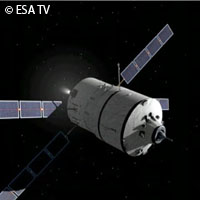A glorious finish for International Space Station resupply ship Johannes Kepler
If on the off chance you happen to find yourself somewhere in the uninhabited South Pacific ocean around 23:00 CEST tonight (Tuesday), don't be surprised if you witness some mysterious space debris tumbling from the clouds. But fear not, rather than an apocalyptic asteroid, it could just be the remnants of the European Space Agency's (ESA) second Automated Transfer Vehicle (ATV) Johannes Kepler, which after a successful refuelling mission at the International Space Station is returning to the Earth's atmosphere full of rubbish from the Station before burning up and self destructing as part of a controlled re-entry. As a few pieces of the unmanned spacecraft could survive the burn-up and fall to Earth, the team from the ESA that designed the refuel ship - as well as its 2008 predecessor, the Jules Verne - have made sure any stray debris will fall into the uninhabited South Pacific to prevent any accidents. After serving its purpose as a refuel ship sent to provide support to the International Space Station, the Johannes Kepler has been filled with some 1,200 kg of waste bags and unwanted hardware by the Station crew, and just like the tonnes and tonnes of natural space debris that collides with the Earth on a daily basis, the 10 tonne spacecraft will effectively 'self-destruct' when it re-enters the Earth's orbit. Since its launch on 16 February 2011 from the Guiana Space Centre in Kourou, French Guiana, the Johannes Kepler has been an instrumental aid for the International Space Station, delivering about 7 tonnes of much needed supplies, including 1,170 kg of dry cargo, 100 kg of oxygen and 851 kg of propellants, to replenish the Station's tanks and 4,535 kg of fuel for the ferry itself to boost the outpost's altitude and make other adjustments. The spacecraft also helped to manoeuvre the International Space Station on 2 April to avoid a collision with space debris. And before its mission drew to a close, it also helped give the Station's orbit a series of final big boosts on 12, 15 and 17 June, which helped raise the Station's orbit to around 380 km. But sometimes all good relationships must come to an end, and after four months of intensive operations the International Space Station crew closed the hatches between themselves and the Johannes Kepler on Sunday afternoon at 17:30 CEST and the spacecraft undocked from the Station yesterday (Monday) at around 17:00 CEST. The ESA has also reported that the Johannes Kepler conducted an unexpected debris avoidance manoeuvre on Monday at 20:30 CEST. ESA's Mike Steinkopf states: 'Earlier today, NASA flight dynamics predicted an object conjunction with a miss distance of 50 m. The ATV boost (thruster burn) was planned at 1.5 m/s, and took ATV onto a completely safe orbit.' Luckily, the Johannes Kepler has enough spare fuel on board in the event of any other such unexpected manoeuvres. All going to plan, later on today the Johannes Kepler will fire its engines twice to descend from orbit, with a first burn to drop the craft into Earth's orbit at around 19:00 CEST and a second one at 22:05 CEST to direct it towards its target in the South Pacific. Any remains from its disintegration are scheduled to fall into the ocean at around 22.50 CEST. The last contribution the Johannes Kepler will make to space research will be the data it leaves behind in a prototype Reentry Breakup Recorder, much like an aeroplane's 'black box'. As many aspects of a controlled destructive entry remain mysterious, by recording the Johannes Kepler's last moments ESA scientists will be able to gather measurements on the location, temperature, pressure and altitude of the vehicle's breakup before ejecting.For more information, please visit:ATV-2 Johannes Kepler blog:http://blogs.esa.int/atv/European Space Agency:http://www.esa.int/esaCP/index.html



